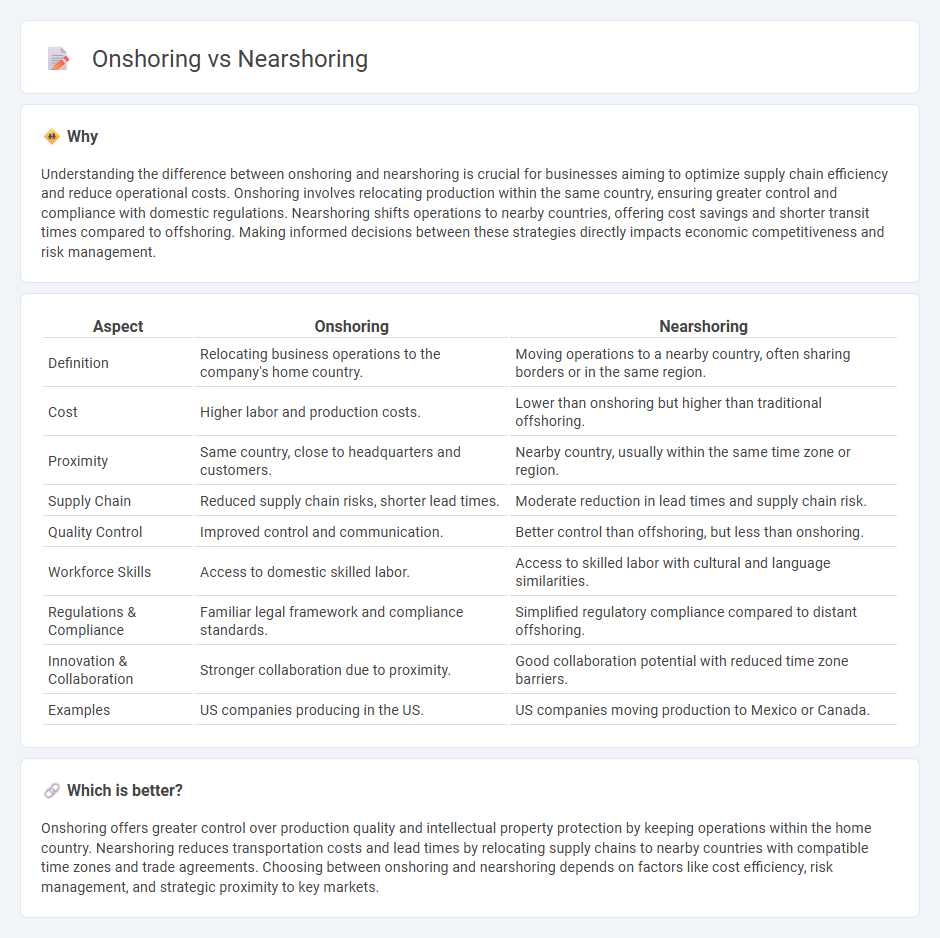
Onshoring and nearshoring strategies both aim to optimize supply chains by relocating production closer to home markets, with onshoring involving domestic manufacturing and nearshoring focusing on neighboring countries. Onshoring reduces dependency on offshore suppliers and cuts transportation costs, while nearshoring offers cost advantages through proximity and shared time zones. Explore the detailed benefits and challenges of onshoring and nearshoring to determine the best fit for your business needs.
Why it is important
Understanding the difference between onshoring and nearshoring is crucial for businesses aiming to optimize supply chain efficiency and reduce operational costs. Onshoring involves relocating production within the same country, ensuring greater control and compliance with domestic regulations. Nearshoring shifts operations to nearby countries, offering cost savings and shorter transit times compared to offshoring. Making informed decisions between these strategies directly impacts economic competitiveness and risk management.
Comparison Table
| Aspect | Onshoring | Nearshoring |
|---|---|---|
| Definition | Relocating business operations to the company's home country. | Moving operations to a nearby country, often sharing borders or in the same region. |
| Cost | Higher labor and production costs. | Lower than onshoring but higher than traditional offshoring. |
| Proximity | Same country, close to headquarters and customers. | Nearby country, usually within the same time zone or region. |
| Supply Chain | Reduced supply chain risks, shorter lead times. | Moderate reduction in lead times and supply chain risk. |
| Quality Control | Improved control and communication. | Better control than offshoring, but less than onshoring. |
| Workforce Skills | Access to domestic skilled labor. | Access to skilled labor with cultural and language similarities. |
| Regulations & Compliance | Familiar legal framework and compliance standards. | Simplified regulatory compliance compared to distant offshoring. |
| Innovation & Collaboration | Stronger collaboration due to proximity. | Good collaboration potential with reduced time zone barriers. |
| Examples | US companies producing in the US. | US companies moving production to Mexico or Canada. |
Which is better?
Onshoring offers greater control over production quality and intellectual property protection by keeping operations within the home country. Nearshoring reduces transportation costs and lead times by relocating supply chains to nearby countries with compatible time zones and trade agreements. Choosing between onshoring and nearshoring depends on factors like cost efficiency, risk management, and strategic proximity to key markets.
Connection
Onshoring and nearshoring both aim to bring production closer to the company's home market to reduce supply chain risks and lower transportation costs. Onshoring relocates manufacturing within the same country, while nearshoring shifts operations to nearby countries with geographic, cultural, or trade advantages. These strategies enhance economic resilience, improve lead times, and support local job creation by minimizing reliance on distant overseas suppliers.
Key Terms
Supply Chain Optimization
Nearshoring reduces supply chain risks by relocating production closer to end markets, enabling faster response times and lower transportation costs than traditional offshoring. Onshoring further enhances supply chain control and resilience by keeping manufacturing within the home country, simplifying logistics and compliance with local regulations. Explore how nearshoring and onshoring strategies can optimize your supply chain for agility and cost-efficiency.
Labor Costs
Labor costs play a pivotal role in the decision between nearshoring and onshoring, with nearshoring often offering substantial savings due to lower wages in neighboring countries. Onshoring typically involves higher labor expenses but benefits from greater control over quality and communication. Explore our detailed analysis to understand how labor costs impact your outsourcing strategy.
Trade Tariffs
Trade tariffs significantly influence the choice between nearshoring and onshoring, with nearshoring offering lower tariff risks due to proximity to major markets like the U.S. Nearshoring to countries within trade agreements such as USMCA can reduce customs duties and compliance costs compared to onshoring. Explore deeper insights on how trade tariffs shape supply chain decisions in nearshoring vs onshoring.
Source and External Links
Nearshoring - Nearshoring is the outsourcing of business processes, particularly IT, to nearby countries, often those that share a border with the client's nation.
Nearshoring in Mexico | Deloitte Insights - Nearshoring is a strategy where companies move production closer to consumers to reduce costs and mitigate supply chain disruptions, with recent global events accelerating its adoption as an alternative to traditional offshoring.
What is Nearshoring? Definition and Benefits - TTEC - Nearshoring is a form of offshoring that involves hiring employees from neighboring countries, offering cost savings, cultural alignment, and logistical advantages due to proximity and similar time zones.
 dowidth.com
dowidth.com